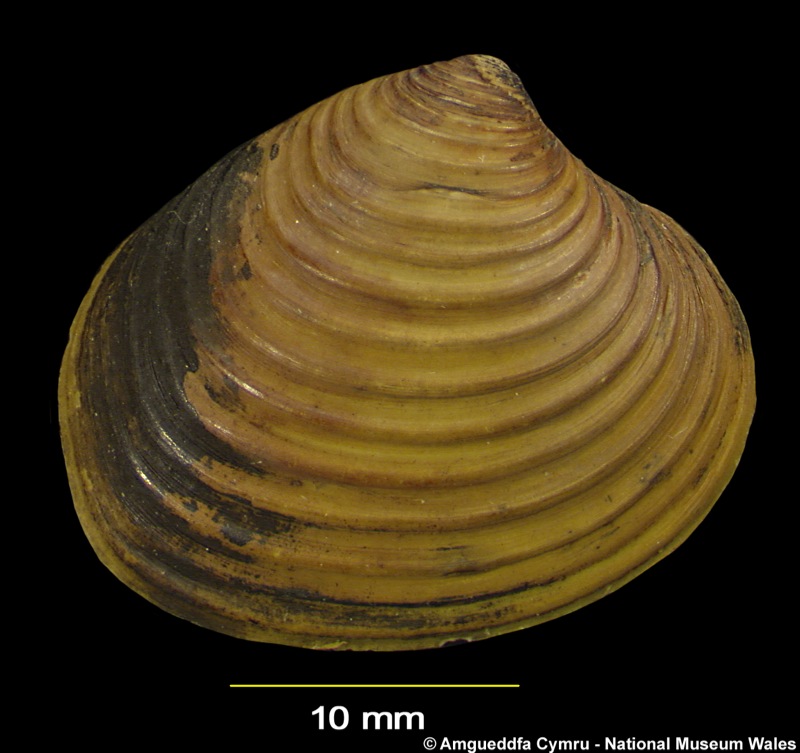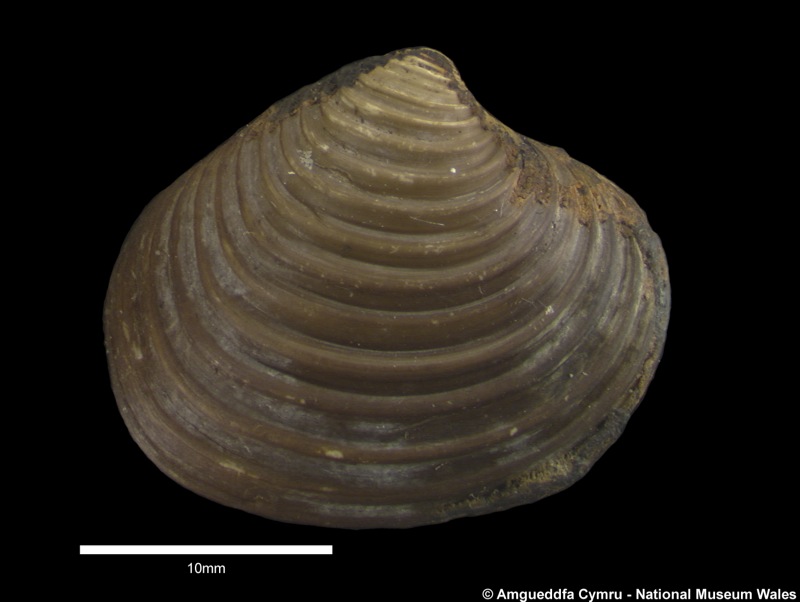Astarte sulcata (da Costa, 1778)
Crassatelloidea : Astartidae |
| Tebble name: | Astarte sulcata (da Costa) |
| Smith & Heppell name: | Astarte sulcata (da Costa, 1778) |
To size: To 30mm. Shell Structure: Solid. Equivalve: Equivalve. Equilateral: Relatively inequilateral, the beaks lie approximately 35% of dorsal margin length from anterior. Tumidity: Slightly tumid. Outline: Sub-ovate to rounded quadrangular, height of shell approximately 90% of the height. Posterior dorsal margin long, gently sloping, very slightly convex to almost straight; anterior dorsal margin more steeply sloping and conspicuously concave; anterior end slightly rounded; posterior end truncated/bluntly rounded; ventral margin gently rounded; lunule distinct, sunken, elongate heart-shaped with well defined, raised edges; escutcheon distinct, lanceolate, with very well defined raised edges. Beaks prosogyrous.
Sculpture: Broad, concentric, strap-like ridges, ranging in number from 25 to over 40 in adult individuals. Margin: Initially smooth, becoming crenulate in older shells. Size at which crenulations appear varies between populations. Ligament: Broad, distinct but not prominently raised, runs for approximately one third the length of the escutcheon. Hinge: Heterodont: Robust hinge plate; right valve with 2 solid, blunt cardinal teeth, the posterior tooth is thin and inconspicuous and the anterior tooth is broad; left valve with 3 blunt cardinal teeth, the 2 anterior teeth are relatively broad and solid whereas the posterior cardinal is very thin and inconspicuous. The posterior part of the right valve has a thickened ridge similar to a lateral tooth. Pallial Musculature: Entire. Periostracum: Ranges from yellowy brown to dark brown, almost black. Dull surface texture with a fine wavy linear pattern. Colour: White.
Distribution & Ecology
Lives in a range of usually silty and muddy sands and gravels from the near sub-littoral towards the shelf edge and on the very upper slope, depth range 5 to 250m or more.
Depth Range
Continental Shelf (to 200m)
Continental Margin Zone (200 - 500m)

Additional Information & Related Species
Key Features & Similar Species
Additional Comments
The presence of a crenulated margin is not a reliable character. Crenulations are not present in juvenile shells and the size at which they appear varies between populations. We suspect that their appearance is age related and not size related and is often associated with a thickening of the margin.
Related Species
Crassatelloidea : Astartidae
References
Listed are literature citing Astarte sulcata (da Costa, 1778). Reference containing the species Type Description is highlighted.
|
da Costa E M 1778. Historia Naturalis Testaceorum Britanniae London: Millan, White, Elmsley & Robson. 254pp, 17pls. |
|
Høpner Petersen G. 2001. Studies on some Arctic and Baltic Astarte species (Bivalvia, Mollusca). Bioscience. 52: 1-71. |
Resources
- Conchological Society
of Great Britain & Ireland
Provides resources for understanding, identifying, recording, and conserving molluscs - CLEMAM
Check List of European Marine Mollusca - MarLIN
The Marine Life Information Network for Britain and Ireland (MarLIN) provides information for marine environmental management, protection and education. It is a centre of excellence in spatially based and time-series marine biological information and supports good stewardship in the marine environment. - NBN Gateway
National Biodiversity Network's Gateway. Use it to explore UK biodiversity data, as contributed by participating data providers. - BivAToL
- MarBEF
- Malacological Society
- Unitas Malacologica
- Census of Marine Life
- MarBEF
MarBEF, a network of excellence funded by the European Union and consisting of 94 European marine institutes, is a platform to integrate and disseminate knowledge and expertise on marine biodiversity, with links to researchers, industry, stakeholders and the general public.

























































